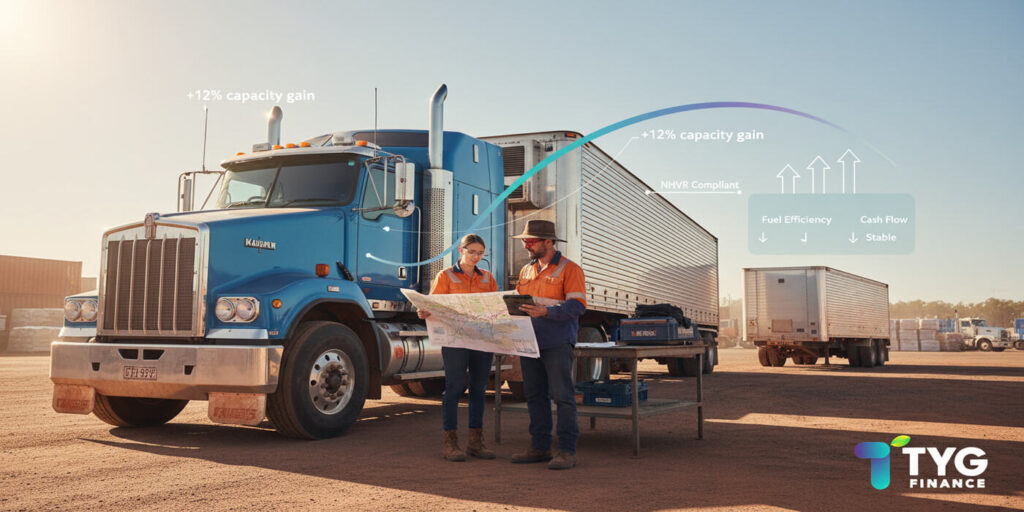Why Fleet Composition Shapes Freight Outcomes
For operators in transport, mining, agriculture, and construction, freight efficiency often comes down to the right mix of trucks and trailers. Selecting assets is no longer simply about horsepower or load capacity. Today, operators weigh payload efficiency, compliance requirements, and long-term maintenance schedules to maximise freight movement and minimise costly downtime.
This guide explores key considerations asset-backed businesses may evaluate when planning their truck and trailer strategy.
Asset Mix: Matching Trucks and Trailers to Freight Demands
One of the first questions operators face is what combination of vehicles and trailers will deliver the best return across varied duty cycles. The wrong mix can limit payloads, reduce flexibility, and increase operating costs.
Common factors operators consider include:
- Type of freight: Perishable goods, bulk commodities, and oversized loads each demand different configurations.
- Route profiles: Steep grades in mining operations may favour prime movers with greater torque, while metropolitan logistics fleets may prefer lighter vehicles with tighter turning circles.
- Versatility needs: Trailers that can be interchanged or reconfigured may extend asset lifespan and improve utilisation rates.
For a closer look at how procurement decisions, compliance, and maintenance interconnect, read our breakdown on common asset mix challenges. Also, explore tailored Truck Finance solutions to align new acquisitions with operational requirements.
Payload Efficiency: Maximising Every Kilometre
Payload efficiency goes beyond raw load limits. It is about ensuring every trip carries as much value as possible without breaching compliance or straining assets.
Some approaches operators often explore:
- Axle configuration choices: Different layouts can balance weight more effectively.
- Lightweight trailer materials: Aluminium trailers may increase payload without breaching gross combination mass (GCM) limits.
- Backloading strategies: Leveraging data and logistics planning to avoid running empty.
A recent Infrastructure Australia report highlighted how improvements in freight efficiency could have a ripple effect across the national economy, reducing bottlenecks and boosting competitiveness. Selecting the right moments and reasons for replacement is covered in our fleet replacement planning insights.
Compliance Considerations: Meeting NHVR Standards
Fleet efficiency is only as strong as its compliance record. The National Heavy Vehicle Regulator (NHVR) sets the framework for load limits, fatigue management, and vehicle safety standards.
Operators planning new acquisitions often evaluate:
- Mass and dimension regulations: Ensuring trucks and trailers are configured to stay within allowable limits.
- Fatigue laws: Matching vehicle technology (e.g., electronic work diaries) to driver management obligations.
- Safety requirements: Incorporating features that align with regulatory trends, such as advanced braking systems or underrun protection.
Keeping compliance at the centre of asset planning may help reduce the risk of fines, downtime, and reputational damage.
Maintenance Scheduling: Minimising Downtime
Even the most advanced truck and trailer setup will lose its edge if downtime isn’t managed. Preventive maintenance is often the difference between predictable costs and unexpected breakdowns.
Operators commonly consider:
- Scheduled servicing intervals aligned with manufacturer recommendations.
- Predictive maintenance tools, including telematics that track wear and performance.
- Component standardisation, which simplifies parts inventory and reduces delays.
By embedding maintenance planning into fleet acquisition, operators may avoid the hidden costs of idling equipment and disrupted delivery schedules. For actionable tips on keeping trucks and trailers in top shape throughout the year, explore our spring maintenance strategies.
Financing as a Freight Strategy Enabler
Replacing or expanding trucks and trailers often requires significant capital. Financing can be more than a payment mechanism — it can be a strategic enabler that allows businesses to maintain efficiency while managing cash flow.
Options operators may explore include:
- Truck Finance – Tailored facilities for upgrading prime movers or adding capacity in response to demand.
- Trailer Finance – Flexible solutions for operators needing specialised trailers without upfront capital strain.
For more ways to align fleet investment with efficiency, cost management, and risk, see our fleet management best practices. Learn more about financing options through our Trailer Finance page.
Financing structures that align with operational cycles may help businesses spread costs, plan upgrades strategically, and remain agile in competitive markets.
Practical Example: Balancing Compliance and Payload
Consider an agricultural operator moving grain across regional New South Wales. Their existing trailers were durable but heavier, limiting the payload per trip under NHVR regulations. By exploring lightweight aluminium trailers financed under a structured facility, the operator was able to increase payload capacity per load, reduce trips, and maintain compliance — without tying up working capital.
While every business will have its own considerations, this example highlights how fleet choices intersect with compliance, efficiency, and financing.
Key Takeaways for Operators
- Optimise asset mix by aligning trucks and trailers with the specific type of freight and duty cycles.
- Maximise payload efficiency by considering axle configurations, lightweight trailers, and smart logistics planning.
- Stay compliant with NHVR standards to avoid costly fines and operational disruptions.
- Plan maintenance proactively to keep fleets running at peak efficiency.
- Use financing strategically to enable upgrades without straining capital reserves.
Freight Efficiency Starts with Smarter Choices
In today’s operating environment, trucks and trailers are more than workhorses — they are strategic assets. By carefully balancing payload efficiency, compliance, and maintenance, operators can optimise freight outcomes while keeping downtime to a minimum.
Financing solutions can support these decisions, helping businesses act decisively when opportunities or needs arise.
Begin your finance journey with TYG Finance and explore smarter ways to optimise your freight strategy.


